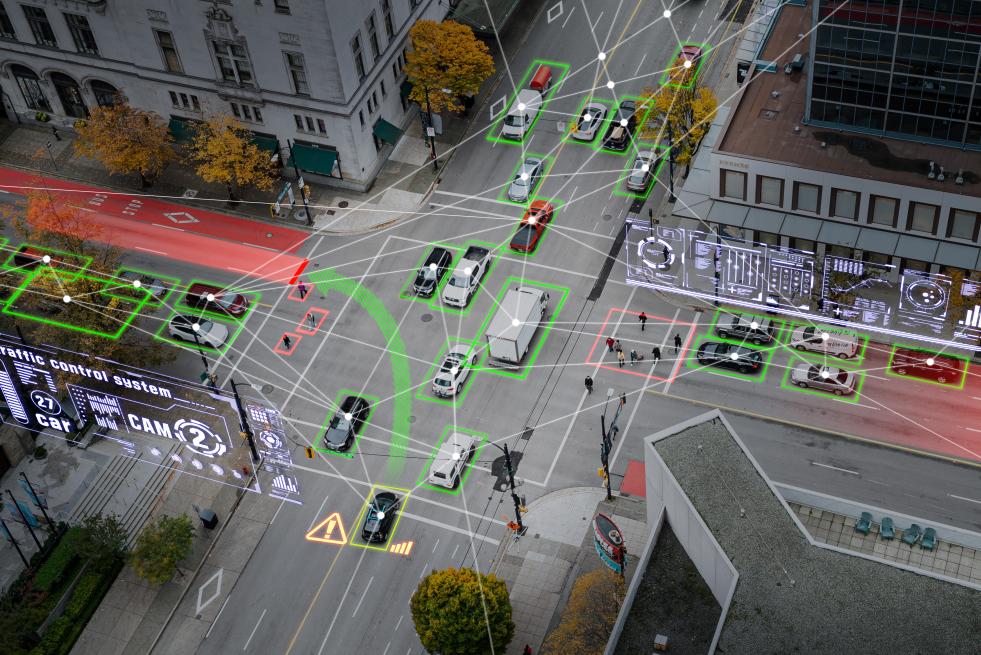In the late 1990’s, Iteris began offering systems for vehicle detection using video cameras. The algorithms developed then, known as traditional algorithms, were built on machine vision technologies and were continuously innovated, adjusted and improved over time.
Our approach involved employing various methodologies to differentiate objects from the roadway, ensuring our detection confirmed the authenticity of objects and distinguished them from potential confounders such as shadows or other phenomena. This process was imperative to prevent any erroneous calls to the traffic controller.
Moving from traditional algorithms to Artificial Intelligence
Today we have reached and even stretched the limits of what traditional algorithms can do to improve detection performance, identify, and classify objects and deal with tough vision conditions. We are, essentially, squeezing the last drops out of the can.
With this in mind, Iteris made the conscious decision several years ago to develop a system capable of harnessing the power of Artificial Intelligence (AI) in a detection system. This was the birth of Vantage Apex, the industry’s first full 1080p high-definition (HD) video and 4D/HD radar hybrid sensor with integrated AI algorithms.
When using AI in our systems, we must address two challenges:
1. AI is evolving rapidly
This is true, but so are we! We have a very smart team of individuals working on programming our AI, and as AI evolves, so does the way we program.
2. Processors need to keep up with AI
This is indeed a challenge for some—luckily, we are using NVIDIA processing, the leader in the industry, and it has what it takes to keep up.
How does AI see?
Our current implementation of AI uses Convolutional Neural Networks (CNNs). These networks use multiple layers to mimic how the human brain sees and then recognizes an object.

Figure 1 – A demonstration of what a human sees and how the Neural Network interprets it
Referring to the graphic above:
- The first set of layers works similarly to our traditional algorithms. They find features such as edges, shapes, blobs, and things that do not occur in nature.
- The second set of layers tries to match these features to known objects. Is this part of a car, truck, bike, or pedestrian?
How does the system know what these things are? As I mentioned earlier computers and AI need to be trained to be effective—this is where we come in.
Over the past three years, we’ve worked to establish an expansive annotation library, boasting an impressive 150,000+ meticulously curated images and encompassing more than 1 million diverse objects. This exceptional collection of training data is uniquely tailored to our camera field of view and ensures we lead the field in artificial intelligence at the intersection.
What is Iteris doing with AI in its detection systems?
Vantage Apex with its integrated AI is the ideal system to perform several key tasks at the intersection:
- Efficiency: The system can be used to support real-time signal phase adjustment, ensuring that traffic engineers can move the maximum number of vehicles, bicycles and pedestrians through their traffic network.
- Safety: Vantage Apex and AI may be used to support collision avoidance efforts for red-light runners with safety features and applications such as red protect.
- Connected Vehicles: With AI’s ability to distinguish between various classes of vehicles we can enhance the data contained in various types of CV messages such as basic safety messages (BSMs) pedestrian safety messages (PSM), collective perception messages (CPMs) and sensor data sharing messages (SDSMs).
- Data: Classes of road users have been vastly expanded when compared to the classification capabilities in our traditional algorithms.

Figure 2 – Vantage Apex classifying vehicles in real time
Vantage Apex’s AI in Action
While certainly not the only example of our AI at work, here’s a good one: Vantage Apex and artificial intelligence can be used to detect when a vehicle, within a trip line at an intersection, will not stop for a red light. The sensor can then alert the traffic signal controller to extend the opposing red light until the speeding vehicle is safely through the intersection. The offending vehicle’s signal would also remain red, allowing for drivers to be ticketed while drastically reducing crashes caused by red light running.
What’s next in AI?
Research in AI models has moved from Convolutional Neural Networks to Large Language Models and Large Vision Models—these are still Neural Networks but use a different method to interpret the image providing an even higher level of performance.
We continue to review processing platforms and tools needed to implement the best-in-class performance for our customers and are always ahead of the game in implementing the latest technology in our products.
For detection, we continue to move from traditional to AI algorithms—fusing the power of both algorithm types. Another natural step forward is to combine our radar sensor data with the AI algorithm, creating an extension of our current sensor fusion efforts between our traditional algorithms and radar sensors.

Figure 3 – Graph of the transition from traditional to AI Algorithms
With the advancements being made all the time, Vantage Apex will be able to render a digital twin representing the trajectory of objects at the intersection, making it possible to share geolocation and other related information at scale, in near-real time. It will also be able to distinguish vehicle types, making vehicle prioritization at the intersection effortless.
Artificial intelligence is opening so many applications and opportunities to us that it’s difficult to list them all. They range from data expansion, increasing safety and improving efficiency along with what we will do in the world of connected and automated vehicles.
But it means that the future is very exciting, and it’s coming fast. Here at Iteris, we’re at the forefront of implementing this new technology and putting it to excellent use in the transportation world.
---------------------
This is just the first in a series of AI-related blogs highlighting our approach to AI and how we’re utilizing it—look out for more coming soon! Interested in how AI is enabling the connected transportation network of the future? Check out our AI in Transportation white paper.
About the Author:

Michael Whiting is VP, Advance Sensor Technologies at Iteris.
Connect with Michael on LinkedIn.
 Click the banner above to schedule a meeting with our experts ahead of ITS America!
Click the banner above to schedule a meeting with our experts ahead of ITS America!



